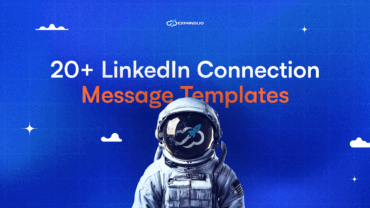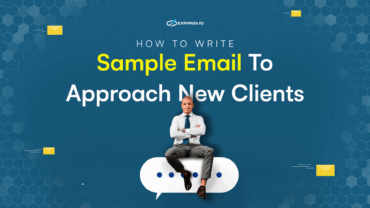The Follow-Up Formula: How to Get More Replies to LinkedIn Outreach (Templates)

A well-crafted LinkedIn follow-up can double your chances of getting a response — turning cold connections into meaningful conversations.
The difference between follow-ups that work and those that don’t?
It’s not persistence alone, but strategic timing and added value of each follow-up.
There’s a narrow window where your outreach still feels relevant without crossing into spam territory.
So, how do you follow up effectively without sounding desperate or robotic?
You build sequences based on behavior and create personalization touchpoints.
This guide shows how to do exactly that with real examples, specific steps on designing outreach campaign logic, and message templates that go beyond “Just checking in.”
Key Takeaways
- Focus on building relationships to make your follow-ups relevant. Leave genuine comments, ask questions, and engage with their content. When your name becomes familiar, the outreach doesn’t feel “cold”.
- The most successful outreach campaigns include multiple follow-ups. To save time, you can automate follow-ups with Expandi. Just make sure your follow-ups are personalized and add value. To stand out, you can record a quick Loom or use AI to refine your strategy.
- Experiment with different follow-ups and run A/B tests to know what works based on data. Test different CTAs, visuals, connection request templates, timings, and double down on what you know works.
Do LinkedIn follow-ups actually work?
Yes, when you approach them strategically. If you’re not following up, you’re leaving replies — and deals — on the table.
Most sellers give up after one message.
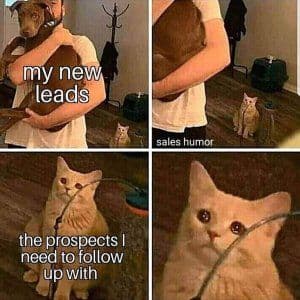
But according to our State of LinkedIn Outreach H1 2025 report, it’s a huge mistake as smart follow-ups significantly improve reply rates:

It goes this way:
- 1st message: Baseline performance
- 1st follow-up: Slight dip (−0.6% replies vs. sending one message)
- 2nd follow-up: +4.05% more replies
- 3rd+ follow-ups: Small gains (around +1%) but diminishing returns
Why does that second follow-up perform so well?
Unlike sophisticated email platforms with filtering and categorization, LinkedIn messages are simple and chronological.
As explained by Laura Hannah, Founder of Pitch121:
“LinkedIn’s inbox functionality is quite basic, which makes it easy for messages to get buried. Similar to email forwarding, a follow-up message effectively brings your original message back to the top of the recipient’s inbox. This visibility increase is particularly effective with the second or third touchpoint.”
Laura Hannah, Founder of Pitch121
So what does this mean in practice?
You don’t need to send 7 follow-ups to get results. But stopping at one message is a huge missed opportunity. The best reply rates come from a well-timed second or third follow-up, not just hammering the same CTA.
The key isn’t just persistence. It’s evolving the conversation and using the right triggers.
Let’s walk through how to build that progression.
How to write smart follow-up LinkedIn message sequences
Here’s how you can build a follow-up engine that feels natural, earns attention, and gets replies.
1. Build a relationship first to make your follow-ups relevant
Always focus on building awareness and trust: before you ever send a message, when you follow up, and even after you’ve started the conversation.
When your name becomes familiar, your outreach no longer feels “cold.”
It feels earned.
But: there’s a difference between warming up leads and fake engagement. This process should feel natural and authentic, not forced.
| Effective | Less effective |
| Your name is already familiar because you’ve shown genuine interest in the person’s work. | You’ve dropped a few vague “great insights!” comments that clearly feel automated and random. |
For example, this comment feels genuine and engaging:

While this one looks like it was generated by AI (which it probably was):

To create a relationship needed for effective LinkedIn follow-ups, design a sequence of touchpoints (spaced out across 3-5 days) that feel relevant and organic. For example:
⚡Customize your LinkedIn profile: Here, Laura Hannah suggests:
“Work small, highly-targeted batches and customize your LinkedIn profile, particularly your headline, to resonate with that specific audience. Creating relevance by highlighting common ground in your connection request significantly increases both acceptance and reply rates.”
Laura Hannah, Founder of Pitch121
⚡Add a personalized note when sending a connection request: While not required, adding it improves response rates.
⚡ View their profile strategically: When someone sees that you viewed their profile, it sparks curiosity. Especially if they later notice you liked their post or commented on something they shared. Do this 3-5 days before sending a connection request for maximum impact.
⚡ Like a couple of recent posts: Ideally, do it consistently over time (once every 2-3 days) rather than liking five posts in five minutes, which feels automated.
⚡Follow their company page: Most people focus only on personal profiles. But liking/commenting on a company’s post can earn recognition from multiple stakeholders.
⚡ Endorse a real skill: If it’s someone senior or public-facing, a single, relevant skill endorsement can show you recognize their expertise. Don’t overdo this. But once? Smart move.
⚡Tag them in a relevant post you’re sharing: If you’re posting your own content, tag them if it makes sense:
“Saw [First Name]’s take on this last week — here’s another angle on the same challenge.”
Only do this when there’s a genuine connection between your content and their expertise or interests. Otherwise, it feels forced.
⚡Attend the same event and follow up after: After a webinar or conference, send a message like:
“Great seeing you at [Event Name]. What did you think about [Speaker]’s point on [specific topic]? I found their approach to [challenge] particularly interesting as it relates to [prospect’s industry/challenge].”
⚡Drop a relevant comment that adds to the conversation: Instead of a generic “Great point!”, try something like:
“Totally agree, [First Name]. Reminds me of what [An Influencer/Expert] said recently on this topic – curious what your take is?”
All past engagement of this kind makes your follow-ups more relevant and personalized. Which drives better results than simply repeating the same message and nagging the contact to reply.
Yes, it sounds like a lot of work. But it doesn’t have to be.
To automate this process, start a Builder Campaign in Expandi and add engagement triggers to send personalized follow-ups.
Click “Create a new campaign” → “Create campaign from scratch”, select Builder, and click “Create a blank campaign.”
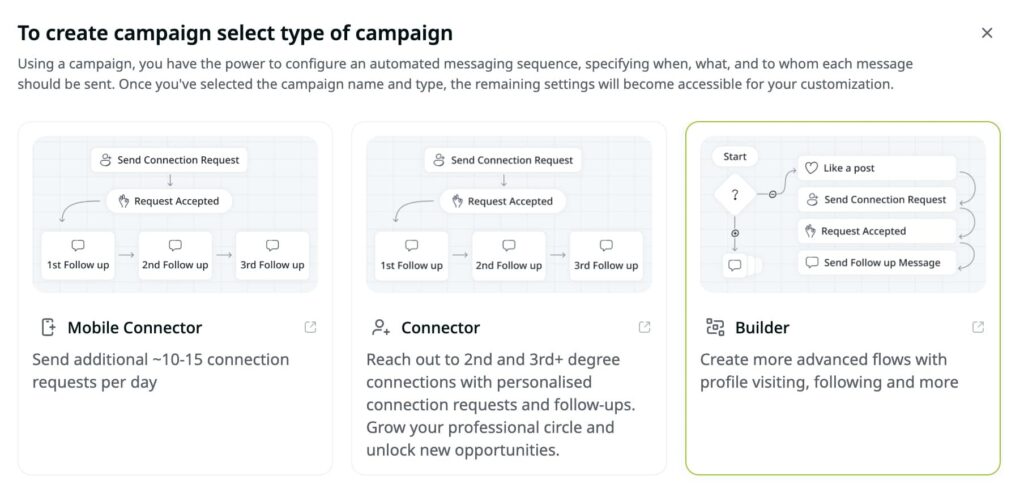
Then, set a goal for your campaign by filling out the fields in the pop-up window. Enter your audience, how you help them, and what you hope to accomplish.
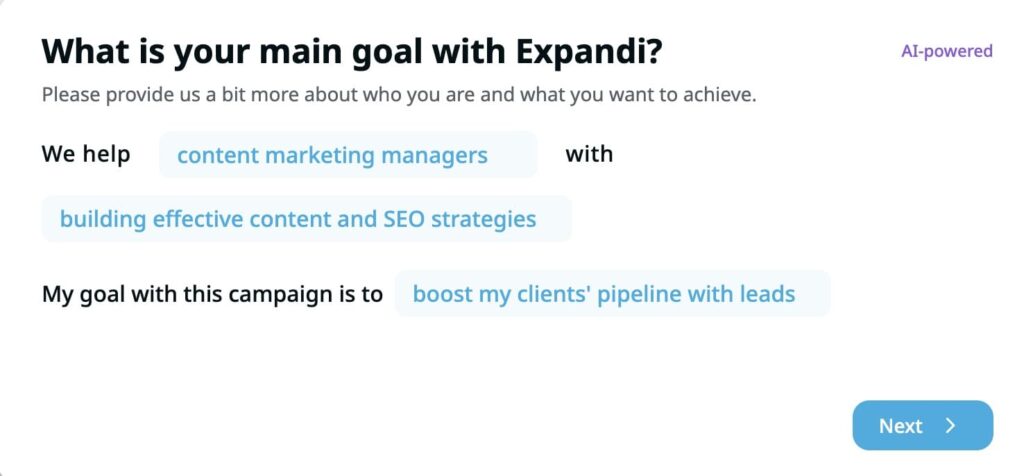
From here, you can design your entire follow-up strategy without leaving the tool. For example:
- Automate the warm-up (e.g., by adding profile visits and likes) and send a connection request.
- Add an “If connected” condition to create two paths based on connection status.
- For connected prospects: Send a personalized first message referencing the specific content you engaged with.
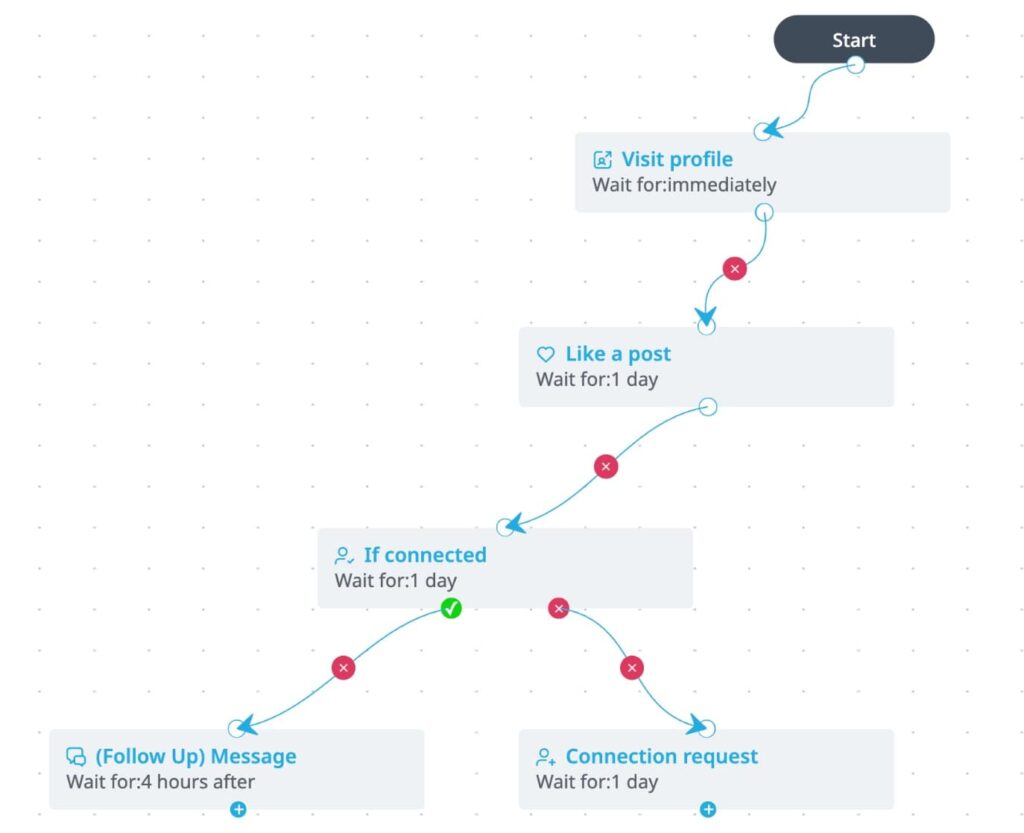
2. Automate follow-ups without getting annoying
You’ve warmed up your leads by strategically engaging with their profiles and content.
Now it’s time to build on those interactions with follow-up messages that feel natural, not pushy.
Most sales teams sabotage their follow-up efforts in one of three ways:
- They give up after a single attempt, missing the 4.05% response boost that comes with a well-crafted second follow-up.
- They stack messages too close together, bombarding prospects with daily check-ins.
- They repeat the identical ask in every message (“Just wanted to see if you had a chance to look at my previous message about booking a call”).
This approach almost never works:
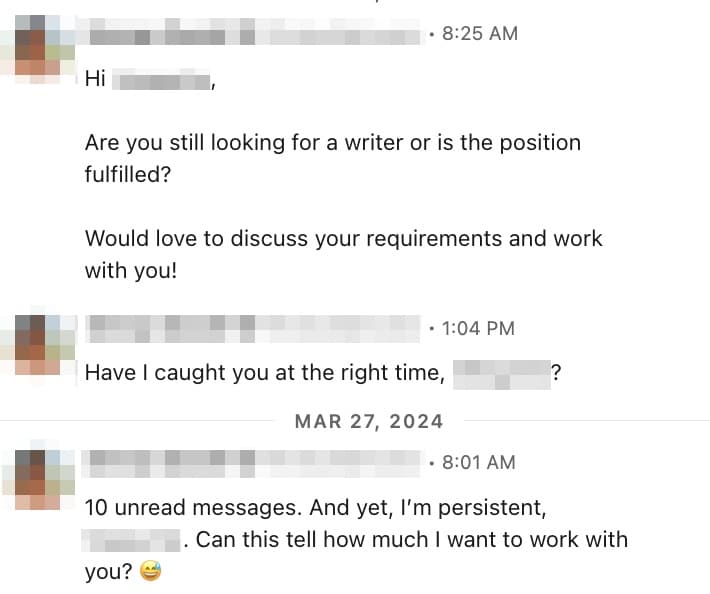
The most successful follow-up strategies progress.
Each message should build on previous interactions and respect the natural rhythm of professional relationships.
Here’s how to achieve it.
⚡Space messages over multiple days
After your warm-up activities and initial connection, maintain that natural conversational flow with appropriately timed follow-ups.
In Expandi, set strategic delays between messages — e.g., 4-7 days between subsequent messages — and increase intervals with each new touchpoint.
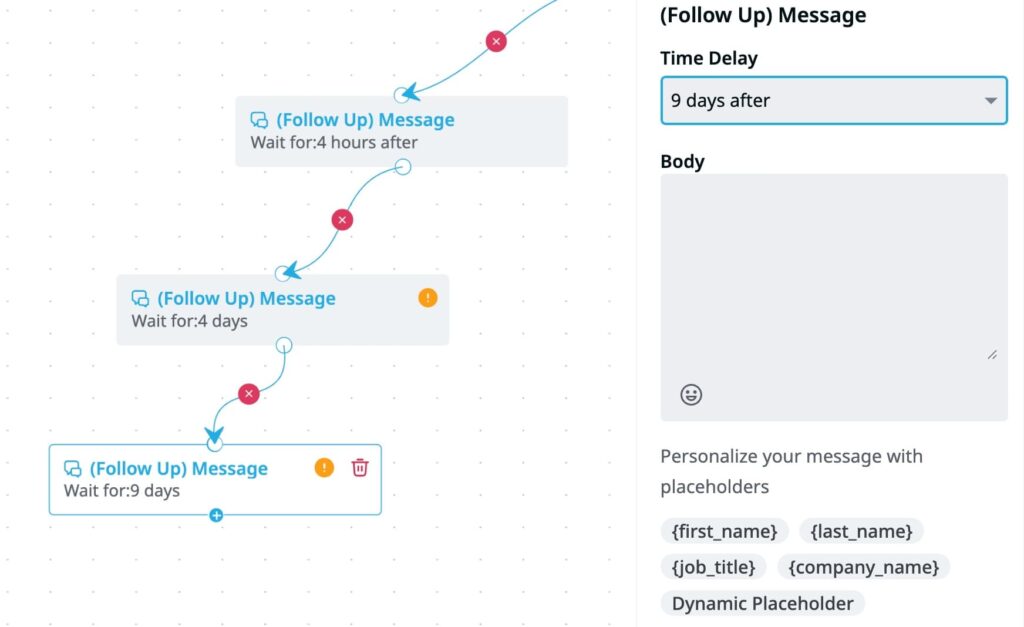
⚡Create dynamic follow-ups based on lead behavior
Different prospects interact in different ways: some visit your profile without connecting, others connect but don’t reply to messages, and some engage with your content but not your direct outreach.
The most effective follow-up sequences adapt to these varied behaviors.
Instead of sending identical messages to everyone regardless of their engagement level, tailor your approach based on their specific actions.
For example, if the prospect liked your recent post, schedule a message referencing the content they engaged with:
“Hi {first_name}, I wanted to share this industry report that addresses the {industry challenge} I described in my latest post. I thought the section on {specific topic} might be particularly relevant to your work at {company}. Happy to discuss if you’re interested.”

⚡Expand follow-ups across channels for better coverage
Some prospects are also more active on LinkedIn, while others prefer email communication.
Rather than limiting yourself to a single channel, integrate your LinkedIn outreach with email to create a cohesive multi-channel approach.
In Expandi, enable the Smartlead integration that lets you transfer prospects directly from your LinkedIn campaign to your email sequences at any point in your outreach flow.
The “Integrations” action in Builder Campaigns creates this bridge between platforms.
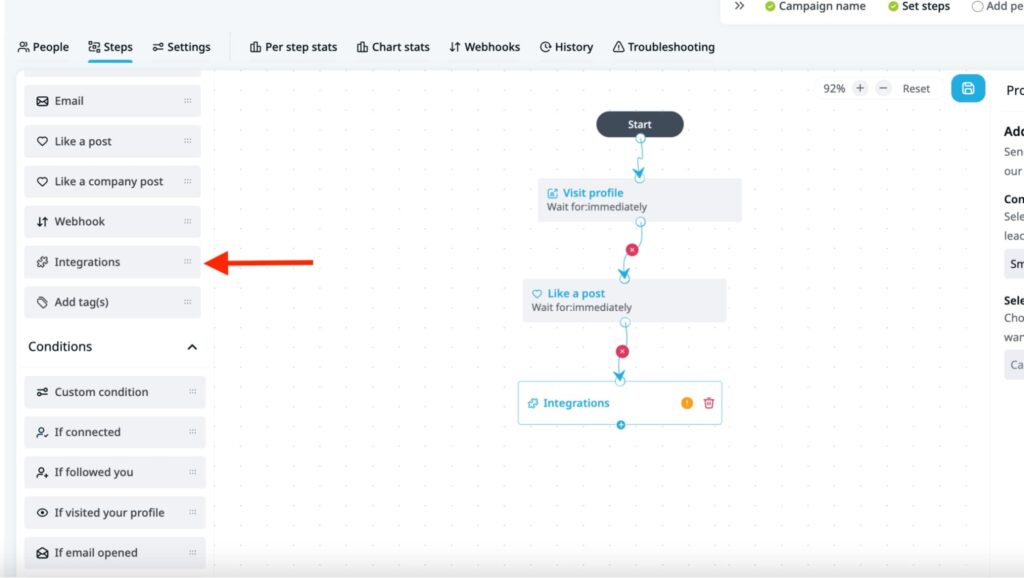
You can then strategically position it at several points in your follow-up sequence:
- After a connection request isn’t accepted within a certain timeframe
- When a prospect accepts your connection but doesn’t respond to messages
- As an alternative pathway for prospects who match specific criteria
For example, you might create a Builder Campaign that attempts LinkedIn connection, sends a follow-up LinkedIn message after connection, then routes prospects to email outreach if they don’t respond on LinkedIn after 12 days.
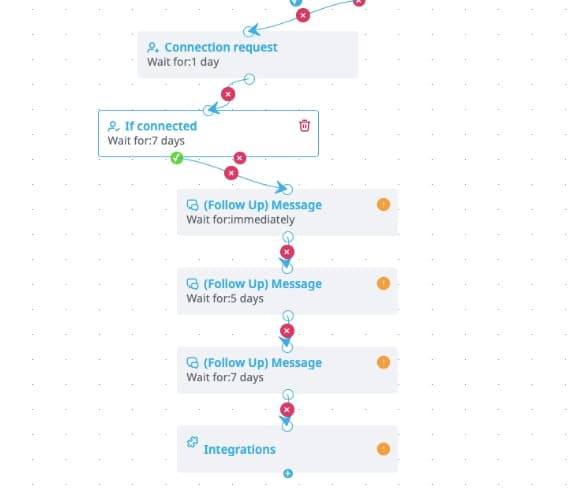
The key is maintaining context between channels. Your email outreach should acknowledge previous LinkedIn interactions to create a seamless experience.
3. Craft personalized follow-up messages that add value
Most LinkedIn follow-ups fail because they sound like they came straight from a playbook.
You know the ones: “Just checking in on my previous message…” or “I wanted to circle back…”
These messages scream “I’m following a script,” not “I’m trying to build a relationship.”
But here’s the thing: even if you’re automating your outreach (and let’s be honest, at scale, you need to), your messages should still feel like they were crafted specifically for the recipient.
Let’s see how you can do it.
⚡Add thoughtful personalization
In Expandi, start by adding basic personalization elements like {first_name}, {company_name}, or {job_title}.
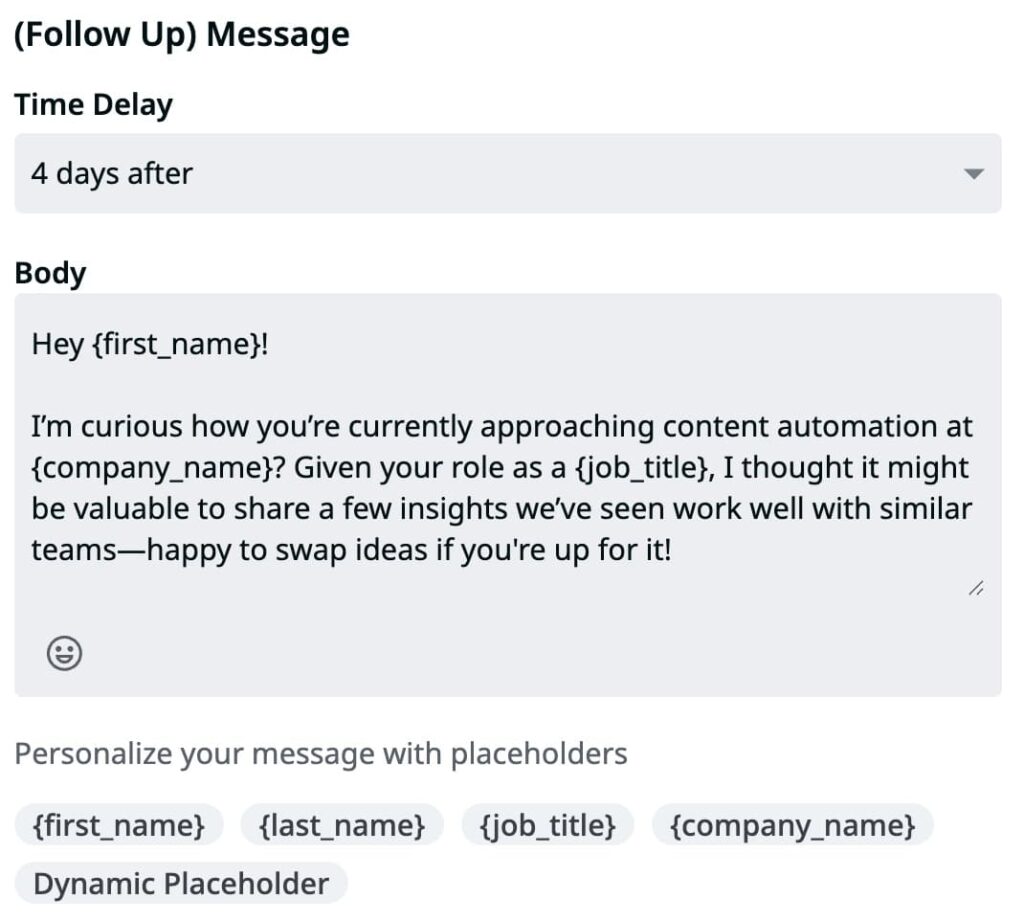
Then, consider additional personalization ideas based on the prospect’s profile and your past interactions — e.g., a mutual connection or a recent company announcement.
Laura’s approach to that first post-connection message is brilliantly simple:
“I approach conversation management through three essential pillars:
- Show genuine interest in them
- Mirror their communication style
- Add meaningful value
For that critical first post-connection message, I focus primarily on the first pillar to generate a response. I keep my questions broad enough that they can answer quickly, allowing them to talk about themselves or their priorities.”
Laura Hannah, Founder of Pitch121
⚡Be creative and memorable
Think about ways to go the extra mile to attract your prospect’s attention.
For example, by following up with a personalized video.
The best part: It actually works. Expandi’s users who try our SendSpark integration achieve up to 16x more replies compared to plain-text DMs.
Here’s how to do it:
- In Sendspark, record a short video (e.g., “Hi there, wanted to quickly show how we help [job title] at [company name] solve [pain point].”)
- Use Sendspark’s dynamic variables to personalize it automatically (adding each lead’s name, their company logo, or even their website in the background)
- Grab the Sendspark video link and paste it into your Expandi campaign canvas.

As a result, your prospects will receive more engaging, personalized messages that show you’re making a real effort.

⚡Come up with a theme for each new follow-up
Finally, don’t assume your prospects are thinking about your solution.
Use the strategies we discussed above — like referencing past interactions and creating video content — to create value-driven follow-ups.
For example:
Follow-up 1 – Share a relevant resource
“Saw you’re working on [topic]. Thought you might find this industry report useful. It breaks down the trends we’re seeing across [sector]. Curious what you think?”
Follow-up 2 – Reframe your offer or share a new insight
“Realized I may have framed things too broadly last time. Here’s how we helped [similar role/company] solve a similar challenge in Q1.”
Follow-up 3 – Send a personalized demo clip
“Made you a quick 60-sec video to show how this works. Figured it’d be easier than explaining via message.”
4. Use AI to refine your messaging strategy (not to replace you)
When a lead finally engages, this is your moment to shift from automation to human and move the conversation forward naturally.
However, AI can assist you in this process.
It can’t build relationships for you, but it can help you write smarter, prioritize better, and follow up based on how people actually respond.
For example, use it to:
- Track sentiment: Instead of manually sorting through replies, use AI to understand whether someone is curious, cautious, or cold and route your replies accordingly.
- Improve your message quality: When you’re stuck, use AI to generate or polish LinkedIn message copy. It won’t write a masterpiece, but it’ll get you 70% there so you can tweak it with your voice.
- Reply faster with context-aware suggestions: Once someone replies, AI assistance helps you move the conversation forward faster.
In Expandi, enable Sentiment Analysis in Settings.

Once you start getting replies, the tool will automatically tag the responses based on their level of interest.

You can then filter by sentiment to prioritize warm leads and develop appropriate follow-up strategies for each sentiment category. For instance:
| Sentiment | Follow-up approach | Sample message |
| 👍 Interested | Schedule a booking or demo | “Great to hear! I’ve got some time tomorrow at 2 pm or Friday at 10 am. Which works better for you to see this in action?” |
| 🤔 Maybe | Add value, address hesitation | “Totally understand you’re cautious. Here’s a quick case study of how we helped [similar company] solve this exact challenge last quarter.” |
| ❌ Not Interested | Respectful close, add resource | “No problem! Timing isn’t always right. Here’s a resource on [topic] I thought you might find helpful anyway. Happy to reconnect down the road.” |
Next, use AI to generate replies faster without leaving your inbox.
To create a reply, click on the Generate reply button located in the opened conversation window with the lead.

This approach combines the efficiency of AI with your personal touch, letting you focus your energy on building relationships rather than crafting every message from scratch.
5. Experiment with your follow-ups and run A/B tests
Even strong LinkedIn messages can flop without testing.
The idea is simple: test two slightly different campaigns, see which one performs better, then double down on what works.
But to get real insights, only tweak one variable at a time. Otherwise, you won’t know what made the impact.
For instance:
| Test focus | Campaign A | Campaign B |
| Message tone | Friendly and casual: “Thought I’d say hi!” | More direct: “Can we connect about X?” |
| CTA style | Ask for a quick Zoom call | Suggest continuing over email |
| Connection message | Just “Hey, would love to connect.” | Include a quick sentence on why you’re reaching out |
| Follow-up content | Send a PDF/resource | Share a video |
| Visuals | Plain text message | Hyper-personalized GIF using Expandi + Hyperise |
| Channel strategy | LinkedIn-only | LinkedIn + fallback email (using Smartlead) |
| Timing | 2-day gaps between messages | 5-day gaps between messages |
You can also automate this step in Expandi.
First, set up two campaigns and choose the same campaign type for both (such as Connector, Messenger, or Builder).
For example, one campaign can have a casual, friendly tone, and the other a more direct, formal one.
Make sure to only change one element between the campaigns, such as message wording, follow-up timing, use of GIFs, etc.
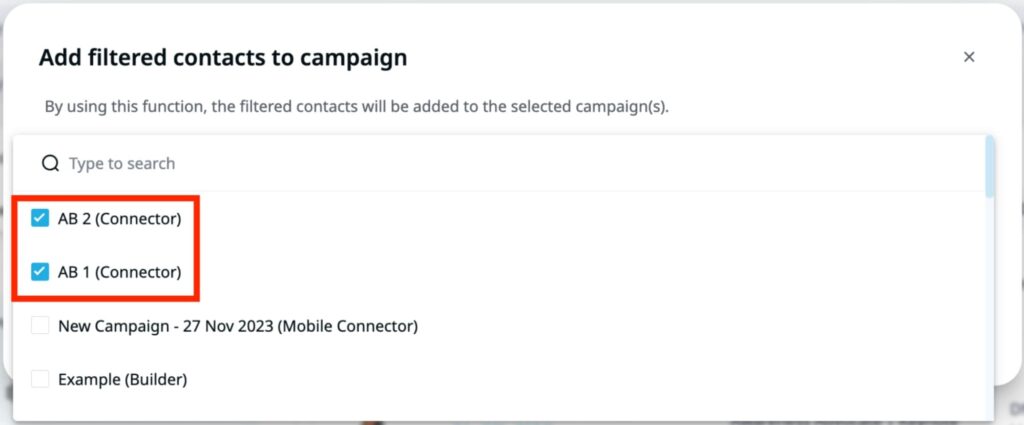
Once your setup is complete, Expandi will randomly and evenly split your leads between the two campaigns and help you track performance in real time.
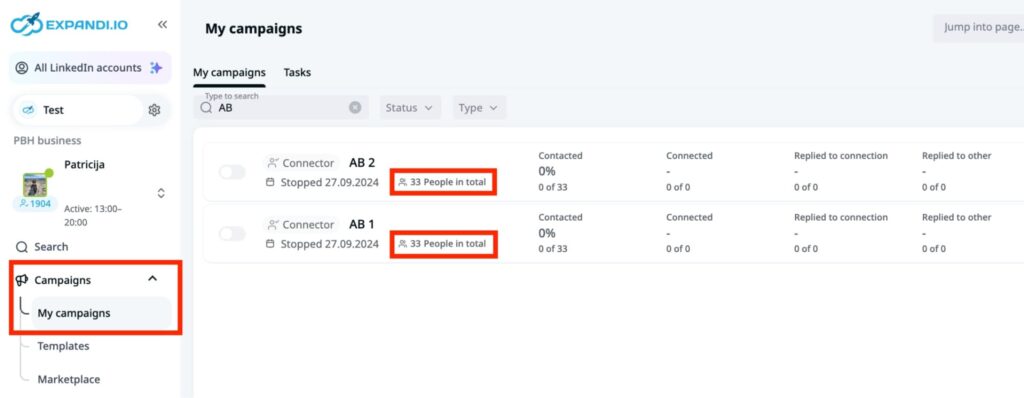
Compare reply rates and connection approvals to see which approach is the most effective.
6. Know that low months happen and adapt accordingly
Even strong outreach campaigns can go quiet, especially at the start of the year or around major holidays.
Think January: people are catching up after time off, budgets are still being finalized, and inboxes are flooded. Or December, when everyone is closing the year and getting ready for holidays.
And it’s true for all outreach channels.
For instance, according to Belkins’ 2024 cold email outreach study, December had the lowest reply rate of the year at just 4.67% —most likely due to the holiday season.
It’s not you — it’s timing.
Instead of panicking, shift your mindset:
- Use slower months to refine messaging, test new formats, or focus on warmer leads.
- Keep showing up. Outreach is a long game and consistency wins.
- View dips as data. If engagement drops across the board, it’s likely seasonal, and not a sign your campaign’s broken.
When automating, adjust your campaign timing and messages during traditionally slow periods.
Consider extending the time between follow-ups by 1–2 days to account for slower response cycles, and make sure your offerings stay relevant.
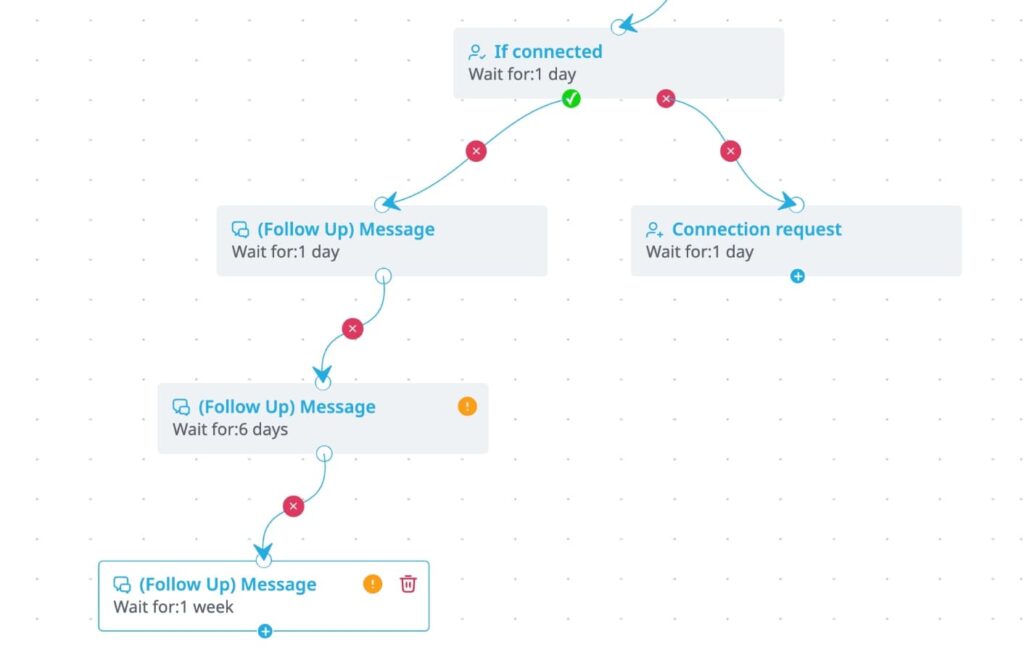
For example, if you’re engaging leads in December, keep in mind they may be focused on year-end closing.
Tailor your message to offer something that can help them during this busy period.
Hey {first_name},
I know this is a busy time with end-of-year planning underway. If you’re mapping out your Q1 goals, I thought you might find this [industry] planning template helpful.
No pitch here, just a resource that’s helped our clients prioritize their Q1 initiatives. Feel free to grab it if useful!
Wishing you a strong finish to the year,[Your name]
Use this time to engage more deeply with your existing network rather than focusing solely on new connections.
LinkedIn follow-up message templates you can steal
That critical first follow-up after someone connects or views your profile often determines whether you’ll get a response or be ignored.
As Laura Hannah, Founder of Pitch121, explains:
“The most common mistake I see is excessive message length. My recommendation is to focus on one clear point and make it effortless for the recipient to respond with minimal consideration time.”
She’s absolutely right. Your prospect isn’t sitting around eagerly awaiting your sales pitch.
They’re busy, distracted, and probably dealing with a dozen other messages. Your job is to make engagement as frictionless as possible.
A good self-check: if you find yourself frequently using “I,” “we,” or your company name — pause and redirect the focus back to them.
Let’s look at templates that follow these principles for different follow-up scenarios.
Follow-up message after connecting
Keep it light, relevant, and signal context from your initial connection reason.
Hey {first_name}, appreciate you connecting!
Saw your recent post on {topic}. Totally agreed with your point on {specific insight}. Curious how your team is approaching this right now?
It references something specific they shared (showing you paid attention), then asks an easy-to-answer question focused on them.
Follow-up after a webinar or event
Don’t just say “thanks for attending.” Add a value touchpoint.
Hey {first_name}, glad we were both at {event name}.
I put together a short recap of the key takeaways if you want it.
Also happy to share how we’ve helped [ICP] teams tackle the {pain point} that came up in the session.
It offers immediate value (recap) while subtly positioning your expertise around a pain point they’ve already shown interest in by attending.
Follow-up after engagement in comments
When someone likes or replies to your comment, lean into the moment.
Hey {first_name}, appreciate the convo under {mutual connection}’s post!
You made a great point about {shared insight}. I figured I’d say hey here too. Happy to swap ideas or just connect.
This builds on an existing interaction and acknowledges their contribution, making the follow-up feel natural.
Follow-up to a profile view
Add a soft-touch nudge to turn curiosity into conversation.
Hey {first_name}, noticed you dropped by my profile. Hope all’s well!
Not sure if you were looking into {relevant topic} but happy to share what we’ve seen working lately if helpful.
It acknowledges their initiative without assumptions, then offers help without pushing for a specific next step.
Follow-up after no response
These things happen all the time. Bring value, not pressure, and give them a reason to re-engage.
Hey {first_name}, looping back in case my last note got buried.
Thought this quick {resource/video/article} on {topic} might be helpful based on what we discussed. Let me know if you’d like to explore it further.
This recognizes they’re busy (not ignoring you), provides immediate value, and keeps the door open without forcing commitment.
Video follow-up to stand out
As we saw earlier, video can dramatically increase engagement rates. Here’s a template you could use:
Hey {first_name}, thought it might be easier to show rather than tell!
Made this quick 30-second video about {specific challenge/topic} we discussed.
No pressure to watch, but it might give you some ideas for {goal they’re likely working toward}.
It’s novel, demonstrates extra effort, and lets your personality come through in a way text can’t match.
Remember: The best templates are just starting points. Always customize your approach based on the person’s industry, role, needs, recent activity, and communication style.
The LinkedIn follow-up formula that works
Smart follow-ups help you build authentic relationships and boost your campaign results.
To create a sequence that gets replies, think of follow-up as a compound formula:
Trigger → Timing → Tone → Tactic → Takeover
Here’s how it breaks down:
- Trigger: Start from a signal, not a schedule. Profile views, post likes, event attendance: they all add context.
- Timing: Don’t rush it. Leave space between messages and use gaps to build curiosity or show up elsewhere (comment, like, endorse).
- Tone: Friendly, relevant, not overly polished. Ditch the pitch and sound like a real person.
- Tactic: Rotate tactics like soft asks, value drops, helpful resources, questions. Don’t repeat the same CTA and act like a stalker.
- Takeover: The moment they reply? Pause automation. Take over manually and steer the conversation like a human. Use AI to help you, not replace you.
👉Ready to build follow-ups that actually work?
Try Expandi for free and launch your smartest campaign yet. Because in a world of spammy messages, your thoughtful, value-driven follow-ups will be the ones that start conversations.
You’ve made it all the way down here, take the final step


